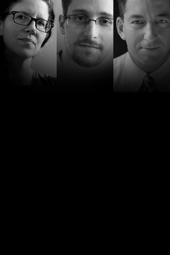Citizenfour, (Laura Poitras, 2014) : GER; US
 Reviewed by Thiago Coelho. Viewed at the Lobero Theatre, Santa Barbara.
Reviewed by Thiago Coelho. Viewed at the Lobero Theatre, Santa Barbara.
A recurrent issue in discussions about non-fiction film is the relationship between documentary and journalism. We have more and more aspects of the documentary in television journalism, and journalism in documentary film. How to distinguish them? Citizenfour is a good example to demonstrate a point of view on this subject.
First, the film has a theme that we know through the media, journalism: in 2013, Edward Snowden, NSA employee (of the US National Security Agency), released with help of reporters, many classified documents showing that the US government had been, for some time, collecting data of millions, perhaps billions of people around the world. This is the brief summary of reported by journalists during these two years since the “appearance” of Snowden in the media.
The director Laura Poitras starts telling that she was approached by Snowden, until then using the pseudonym Citizenfour, and call together with the American journalist Glenn Greenwald for a series of meetings in Hong Kong, where he was hiding. Laura was there and filmed the documentary in question.
The filmmaker then becomes witness to an intrinsically journalistic process, which takes the information to the public, but not as a journalist, but as a documentary filmmaker. How? I suppose Snowden had knowledge of Laura’s work before calling her to the meetings. To call it, Snowden, apparently the real creator of the film, offers an insight into the process. When you do this, create the possibility of documentary emerge parallel to journalism. Laura hardly appears in the meetings, either in picture or sound. She notes the conversations between Snowden and Greenwald then talk to her point of view.
What makes “Citizenfour” essentially a documentary, and so interesting. Despite the revelations made in the talks in Hong Kong, does not seem interested in Laura’s character of the same. The film seems to be focused on the figure of Snowden, even when he says he does not want to be the center of attention. This is where the film becomes unique: it contradicts the revelation of the desire to Snowden, and seems to question him. Then we have the conclusion: the documents fit to journalism; the person behind, and behind the scenes and details of the process, the documentary. At Laura, who delivers this powerful political work, full of teasing and details about one of the biggest complaints of the century.
About this entry
You’re currently reading “Citizenfour, (Laura Poitras, 2014) : GER; US,” an entry on Student Film Reviews
- Published:
- 02.17.15 / 9am
- Category:
- Documentary, Films, Santa Barbara Film Festival 2015
8 Comments
Jump to comment form | comments rss [?]